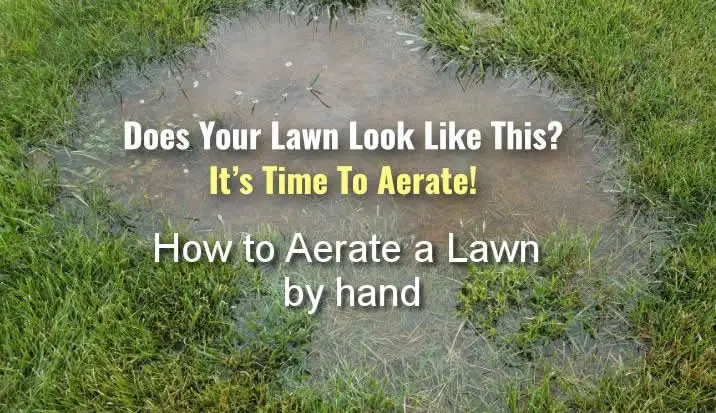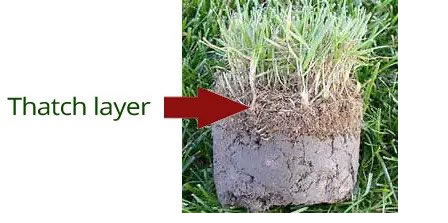Over time the turf on your lawn can become compacted and/or filled with thatch. When this happens much needed water, oxygen and nutrients are stopped from reaching the roots of your grass and plants (if you have them). To make sure your lawn stays in a healthy state you need to take steps to ensure the roots get the water, oxygen and nutrients they need. You do this through a process known as aeration.
Table of Contents
- What It Means To Aerate A Lawn
- When To Aerate A Lawn Using Manual Hand Tools
- The 2 Simple Hand Tools You Need To Effectively Aerate A Lawn By Hand
- To Aerate A Lawn By Hand You Must First Dethatch
- After Dethatching You Can Aerate A Lawn By Hand With Simple Tools
What It Means To Aerate A Lawn
It’s the 21st century and there are modern power tools for just about every lawn job you can think of.
But even though these are easy options some of us prefer to get our hands dirty and do our gardening manually.
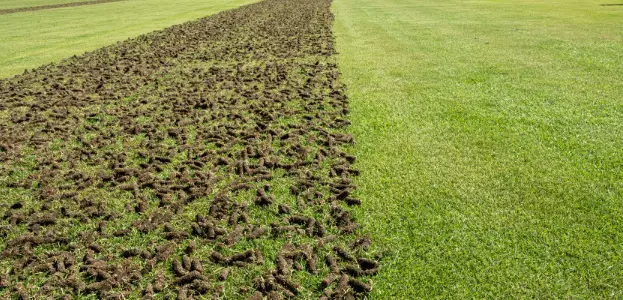
However, modern machinery designed to aerate your lawn can be expensive and bulky so you may want to opt for a more manual approach.
In this article I show exactly how to aerate a lawn by hand and list the tools that are best for the job.
I also show you how to use to use them as well as giving you everyday garden alternatives for those who don’t want to buy specialized tools.
Why you need to aerate your lawn
Aeration is the key to healthy turf and lawns.
Aerating your lawn becomes necessary when the soil becomes compacted due to heavy use or just because it has been used over a very long period of time.
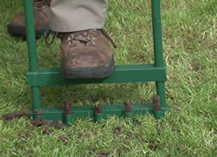 If you and your family or pets frequently use your lawn then chances are you have compacted the turf making the soil hard underneath the top layer.
If you and your family or pets frequently use your lawn then chances are you have compacted the turf making the soil hard underneath the top layer.
Likewise, thatch can develop in your lawn over time.
Thatch is the build-up of grass debris in the soil.
Both compaction and thatch build-up can stop water, oxygen and nutrients from reaching the roots of grass and plants preventing them from growing or causing a listless, dull looking lawn and garden.
Aeration is the process by which you loosen up the soil of your lawn so these much needed elements can get to the grass roots.
You do this by punching holes in the lawn.
But, before you go grab a garden fork and start dotting your lawn with holes be aware that there is a very specific way of aerating.
Simply punching holes in the ground without first knowing what you are doing could cause a lot more harm to your lawn than good.
How you can aerate a lawn by hand
Although there are many modern powered-tools for aerating some of us choose to do the job by hand.
Instead of using engine based aerators (like these ones on Amazon) or ones that attach to a riding lawn mower I find that I get much more satisfaction from aerating by hand.
This is simply because I like gardening.
As I have also become more concerned about my personal carbon footprint I think that by doing as many jobs by hand as I can, rather than relying on fume-creating machinery, I’m doing my bit for the environment.

It is also a lot cheaper to source the hand tools necessary for lawn aeration than it is to buy machinery.
And, at the end of the day, these hand tools give you the same results (as long as you are willing to put in some physical effort).
In addition, buying a machine to do a one-a-year job may require a bigger budget than you are willing to spend.
When To Aerate A Lawn Using Manual Hand Tools
As already mentioned you need to aerate your lawn in order for water, oxygen and nutrients to be able to penetrate the soil to get to the roots of grass and plants.
You therefore need to aerate when the roots are not getting those elements.
So how do you know when that is happening?
When there is thatch build-up you need to dethatch & aerate
Thatch is a layer of organic debris that lies just beneath the surface soil on your lawn.
It is made-up of both dead and living shoots, stems, and roots that have formed a barrier between the roots of your grass and plants and the soil surface.
Living organisms within the soil usually break-up this organic matter but when the build-up develops faster than it can be broken down thatch forms.
Determining if there is a build-up of thatch in your lawn is very easy to do.
You can tell you have a thatch problem in your lawn when the ground feels spongy.
This usually starts to occur when the thatch is greater than 1/2 inch.
If the ground is not spongy and you still want to check for thatch then take a shovel and remove a piece of the lawn down to a depth of about 4″.
If there is thatch greater than 1/2 inch then you need to aerate.
If you have thatch that is several inches deep then it is highly recommended that you dethatch before you aerate.
Dethatching is also known as scarification (covered below).
When soil compaction occurs you must aerate
What’s the point of having a lawn if you can’t enjoy it?
People who love and care for their lawns tend to need to aerate more than those who don’t!
Constant traffic on a lawn, whether it be you, your family or your pets depresses the soil and over time it becomes compacted.
As I addressed above, this compaction, like thatch build-up, stops much needed nutrients, oxygen and water from getting to the roots in the soil.
How can you tell if the turf in your lawn is compacted?
A simple test will let you know if you have compacted soil in your lawn.
Simply take a screwdriver and if you can’t push it all the way through the soil, then it is probably compacted and needs aerated.
If you have just moved to a new home it may be a good idea to aerate the lawn (and scarify/dethatch it) just to be on the safe side. Though you may want to use a shallow aerator unless you are certain it needs done.
If your lawn does not see a lot of “foot traffic” then you will probably only need to aerate it every few years.
However, if you use your lawn a lot then aeration is recommend once per year.
Grass types matter when it comes to hand aeration
Ideally, you should aim to aerate a lawn that has cool season grass, like Bentgrass, Bluegrass, Fescue & Rye Grass, in the early spring or early fall.
If you have planted your lawn with warm season grass such as Bermuda, Carpet Grass, Centipede and St. Augustine & Zoysia for example, then you should aim to aerate your lawn in the late spring.
The 2 Simple Hand Tools You Need To Effectively Aerate A Lawn By Hand
I have already wrote an extensive post showing the best way to aerate your lawn using modern machinery.
There are lots of great tips you can get from that post even if you plan to aerate manually.
Using machinery is probably necessary if you have large amounts of turf to tend to as scarifying/dethatching and aeration are time-intensive jobs.
There are even machines on Amazon that can dethatch and aerate without the need for separate tools.
But, for those who want to aerate by hand you will need the following 2 tools:
- Scarifier or Scarifying Rake.
- Hand Aerator or Large Garden Fork.
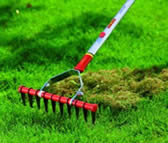 Before you aerate a lawn, especially if you are doing it by hand, it is always a good idea to consider scarifying/dethatching it first for the reasons given above.
Before you aerate a lawn, especially if you are doing it by hand, it is always a good idea to consider scarifying/dethatching it first for the reasons given above.
To Aerate A Lawn By Hand You Must First Dethatch
The only types of hand scarifiers that can effectively dethatch before you aerate
Scarifiers /dethatchers come in various shapes and sizes but they all serve the same purpose; remove thatch build-up under the top soil.
- You can get electric powered dethatchers (see ones here on Amazon) for a completely hassle-free job.
- A popular choice is the roller type thatching cutter rake head (see ones here on Amazon).
- The most common dethatchers are scarifying rakes
as they are cheap are very effective.
How to scarify/dethatch a lawn for aeration by hand
You scarify/dethatch you lawn by simply raking the grass with your scarifying rake.
Do not use a normal garden rake or you will pull up your grass and its roots! You must use a specialized scarifier or dethatcher.
How to dethatch by hand with a rake for aeration (video)
How to dethatch by hand with a scarifier for aeration (video)
After Dethatching You Can Aerate A Lawn By Hand With Simple Tools
The only types of aerators that are effective for aerating a lawn by hand
Aerators come in two types.
- Solid Tine Aerator.
- Hollow Tine Aerator.
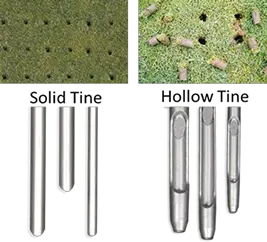 A solid tine aerator refers to the spikes on the tool; in the case of solid tine they are completely solid and punch a hole in the ground forcing the turf deeper at the impact site.
A solid tine aerator refers to the spikes on the tool; in the case of solid tine they are completely solid and punch a hole in the ground forcing the turf deeper at the impact site.
As solid tine aerators compact soil at their contact points I do not recommend using this type unless you are only punching very shallow holes.
Instead I recommend that you use a hollow tine aerator.
Hollow tine refers to the hollow nature of the spikes on the aerator.
Hollow tine aerators are often called core aerators.
A hollow tine aerator will remove plugs of soil from the ground so no compaction occurs.
The plugs can be left to be broken down naturally or raked so they break up which means they will be broken down quicker. raking the plugs also means you won’t be leaving unsightly bits of turf on your lawn. I recommend you rake the plugs.
I recommend you use one of the following tools for aerating your lawn by hand:
- A manual roller aerator
that you push (like an old fashioned reel lawn mower) if you want a solid tine aerator.
- A 2-pronged spade-like aerator
if you want hollow tine (this is what I use when I don’t have access to a machine).
- A foot aerator that is strap-fastened around your shoes. You then simply walk across the lawn to aerate it.
How to aerate by hand (or foot)
There are different types of manual aerators you can use depending on the type of aeration you intend to perform.
If you plan to shallow aerate then you can use simple aerator shoes. These are actually sandal-type coverings that you attach to your shoes via buckled straps and they can be used by simply walking across your lawn.
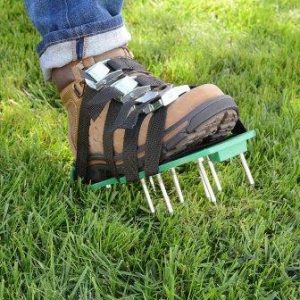 The spikes on aerator shoes are solid tine and only a few inches in length so they will only give you the ability to shallow aerate your lawn.
The spikes on aerator shoes are solid tine and only a few inches in length so they will only give you the ability to shallow aerate your lawn.
I recommend you use a hollow tine (core) aerator with longer spikes (that are hollow) so you can penetrate deeper into the turf without having to worry about compacting it – and thus ensuring the lawn is aerated properly.
You can do this by using one of a variety of aerator hand tools from a manual roller aerator (solid tine) to a 2-pronged spade-like aerator
(hollow tine – recommend).
After scarifying/dethatching your lawn take your chosen aerator tool and use it while moving up and down your lawn.
Always begin by checking the moisture levels in the soil before you aerate by hand
However, before you start aerating, but after you scarify, you will want to ensure the soil on your lawn has the right amount of moisture in it.
If the soil is too wet or too dry you shouldn’t aerate it as you will run the risk of damaging your lawn.

To know if your soil has the right amount of moisture take your aerator and push it into the soil.
The soil should be moist enough to go at least 4″ deep.
If there is a lot of dirt sticking to the inner tubes or it looks very muddy then the soil is likely too wet to aerate.
There is nothing much you can do about this except wait for a few days until it dries – this is one of the reasons why it is not a good idea to aerate in the winter (when the water can turn to ice in the holes and cause a multitude of problems).
If the soil is very dry and powdery, or it is extremely difficult to push the spikes into the ground, then the turf is probably too dry.
You can water the lawn and then try again the next day.
How to use a hand aerator tool effectively
Now that you have prepared your lawn it’s time to aerate it.
Using your chosen aerator you want to start punching holes in the lawn.
If you are using solid tine spikes then you will want to go only about 2″ deep at the most. Going deeper than this may lead to compaction and water logging if it rains. This is known as shallow aeration.
If you use hollow tine spikes on a core aerator then make sure you space each plug hole several inches apart. This is easy to gauge if you are using a 2-pronged spade-like aerator as the 2 core spikes are separated by the perfect distance.
When you finish one row in the garden just make sure the next row is also a few inches from your previous row.
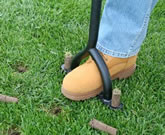 Hollow tine aerators usually aerate to a depth of about 4″ which is perfect.
Hollow tine aerators usually aerate to a depth of about 4″ which is perfect.
When you push down on the hollow tine aerator it will bring out cores of soil leaving your aeration holes (hence the name core aerator).
Continue doing this moving forward by about 4″ to 6″ before pushing the spikes in again.
Do not remove the cores from the lawn. Micro organisms that live in the soil will help to break them down and release the nutrients back into the soil.
It is a good idea to take a rake and run it over the cores to break them down so they are unnoticeable on the lawn and so that they break down quicker.
This is also a good time to seed or overseed.
The best alternative to a handheld aerator tool that you probably already own
Some people use a spading fork to aerate their lawn. To do this you push the fork down into the turf to about a 4″ depth before rocking it back & forth to loosen the soil.
While this is an option I don’t recommend it for the same reasons I don’t recommend solid tine aerators. Plus a a garden fork has even wider spikes that can damage your grass roots, lead to more compacting and just cause problems on your lawn.
Congratulations, you have just learned how to aerated a lawn by hand without the aid of a machine.

